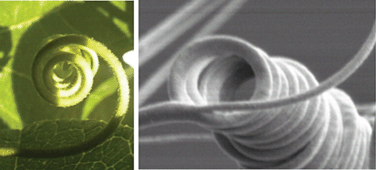How to mimic the shapes of plant tendrils on the nano and microscale: spirals and helices of electrospun liquid crystalline cellulose derivatives
Abstract
We show that suspended nano and microfibres electrospun from liquid crystalline cellulosic solutions will curl into spirals if they are supported at just one end, or, if they are supported at both ends, will twist into a helix of one handedness over half of its length and of the opposite handedness over the other half, the two halves being connected by a short straight section. This latter phenomenon, known as perversion, is a consequence of the intrinsic curvature of the fibres and of a topological conservation law. Furthermore, agreement between theory and experiment can only be achieved if account is taken of the intrinsic torsion of the fibres. Precisely the same behaviour is known to be exhibited by the tendrils of climbing plants such as Passiflora edulis, albeit on a lengthscale of millimetres, i.e., three to four orders of magnitude larger than in our fibres. This suggests that the same basic, coarse-grained physical model is applicable across a range of lengthscales.


 Please wait while we load your content...
Please wait while we load your content...